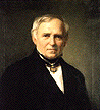

German naturalist, was born at Delitzsch in Saxony on the 19th of April 1795.
After studying at Leipzig and Berlin, where he took the degree of doctor of medicine in 1818, he was appointed
professor of medicine in the university of Berlin (1827). Meanwhile in 1820 he was engaged in a scientific exploration
conducted by General von Minutoli in Egypt. They investigated parts of the Libyan desert, the Nile valley and the
northern coasts of the Red Sea, where Ehrenberg made a special study of the corals. Subsequently parts of Syria,
Arabia and Abyssinia were examined. Some results of these travels and of the important collections that had been
made were reported on by Humboldt ifl 1826; and afterwards Ehrenberg was enabled to bring out two volumes Symbelae
physicae (18281834), in which many particulars of the mammals, birds, insects, &c., were made public. Other
observations were communicated to scientific societies. In 1829 he accompanied Humboldt through eastern Russia
to the Chinese frontier. On his return he gave his attention to microscopical researches. These had an important
bearing on some of the infusorial earths used for polishing and other economic purposes; they added, moreover,
largely to our knowledge of the microscopic organisms of certain geological formations, especially of the chalk,
and of the modern marine and freshwater accumulations. Until Ehrenberg took up the study it was not known that
considerable masses of rock were composed of minute forms of animals or plants. He demonstrated also that the phosphorescence
of the sea was due to organisms. He continued until late in life to investigate the microscopic organisms of the
deep sea and of various geological formations. He died in Berlin on the 27th of June 1876.
PUBLICATION
Die Infusionsthierchen als voilkommene Organismen (2 vols. foL, Leipzig, 1838);
Mikrogeologie (2 vols. fol., Leipzig, 1854); and Fortsetzung der mikrogeologischen Studien, in Abhandl. der
k. Akad. dcr Wissenschafl (Berlin, 1875).